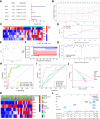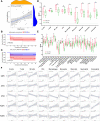Quantitative Proteomics Reveals That a Prognostic Signature of the Endometrium of the Polycystic Ovary Syndrome Women Based on Ferroptosis Proteins
- PMID: 35909514
- PMCID: PMC9330063
- DOI: 10.3389/fendo.2022.871945
Quantitative Proteomics Reveals That a Prognostic Signature of the Endometrium of the Polycystic Ovary Syndrome Women Based on Ferroptosis Proteins
Abstract
Objective: We aimed to study the relationship between ferroptosis proteins and reproductive outcomes of infertile patients with PCOS and construct the related prognostic model.
Methods: These endometrium samples of the study were collected from 33 women with PCOS and 7 control women with successful pregnancies at the Reproductive Center of Lanzhou University Second Hospital, September 2019 to September 2020. The 40 patients' endometrium was identified the differentially expressed proteins (DEPs) using liquid chromatography tandem mass spectrometry. The Kyoto Encyclopedia of Genes and Genomes (KEGG) analysis and Gene Ontology (GO) showed that the DEPs related pathways and functions between PCOS and controls. Subsequently, univariate Cox regression analysis and Lasso regression were used to identifying independent prognostic ferroptosis proteins, which were utilized to establish a prognostic model. Then the performance of the prognostic model was evaluated by receiver operating characteristic curve (ROC) and decision curve analysis (DCA). Then clinical data and prognostic model were used to predict the reproductive outcomes of PCOS patients by constructing the nomograms. Finally, we performed the single sample gene set enrichment analysis (ssGSEA) to explore the correlation between risk scores and immune status.
Results: A total of 5331 proteins were identified, 391 proteins were differentially expressed in the PCOS and controls. The KEGG analysis revealed that the ferroptosis pathway was significantly different between PCOS and controls. 5 ferroptosis proteins (GPX4, DPP4, G6PD, PCBP1, and PCBP2) prognostic model (FerSig) was constructed via Cox regression and Lasso regression. Patients were separated into high and low-risk groups according to the FerSig. Kaplan-Meier curve showed that patients in the low-risk group had much better reproductive outcomes than those in the high-risk group. The DCA showed that the risk score was an independent predictive factor for reproductive outcomes. Compared with clinical data, ROC curve analysis indicated the FerSig proteins as a potential diagnostic and prognostic factor in PCOS patients. Functional analysis revealed that the FerSig proteins and immune microenvironment were correlated to the prognosis of PCOS.
Conclusion: The prognostic model focused on the FerSig proteins could predict the reproductive outcomes of PCOS patients with decreased endometrial receptivity, and provided theoretical basis for individualized treatment.
Keywords: PCOS; endometrial proteins; ferroptosis; prognostic model; quantitative proteomics.
Copyright © 2022 Zhang, Ding, Xin, Yang and Wang.
Conflict of interest statement
The authors declare that the research was conducted in the absence of any commercial or financial relationships that could be construed as a potential conflict of interest.
Figures





Similar articles
-
Autophagy Proteins and clinical data reveal the prognosis of polycystic ovary syndrome.BMC Pregnancy Childbirth. 2024 Feb 21;24(1):152. doi: 10.1186/s12884-024-06273-w. BMC Pregnancy Childbirth. 2024. PMID: 38383330 Free PMC article.
-
Quantitative proteomics reveals pregnancy prognosis signature of polycystic ovary syndrome women based on machine learning.Gynecol Endocrinol. 2024 Mar 8;40(1):2328613. doi: 10.1080/09513590.2024.2328613. Epub 2024 Mar 18. Gynecol Endocrinol. 2024. PMID: 38497425
-
Metabolism-related proteins as biomarkers for predicting prognosis in polycystic ovary syndrome.Proteome Sci. 2024 Dec 19;22(1):14. doi: 10.1186/s12953-024-00238-9. Proteome Sci. 2024. PMID: 39702179 Free PMC article.
-
Identification of the prognostic value of ferroptosis-related gene signature in breast cancer patients.BMC Cancer. 2021 May 31;21(1):645. doi: 10.1186/s12885-021-08341-2. BMC Cancer. 2021. PMID: 34059009 Free PMC article.
-
Endometrial function in women with polycystic ovary syndrome: a comprehensive review.Hum Reprod Update. 2021 Apr 21;27(3):584-618. doi: 10.1093/humupd/dmaa051. Hum Reprod Update. 2021. PMID: 33302299 Review.
Cited by
-
The mechanisms crosstalk and therapeutic opportunities between ferroptosis and ovary diseases.Front Endocrinol (Lausanne). 2023 Jul 27;14:1194089. doi: 10.3389/fendo.2023.1194089. eCollection 2023. Front Endocrinol (Lausanne). 2023. PMID: 37564979 Free PMC article. Review.
-
Exploring the potential role of ENPP2 in polycystic ovary syndrome and endometrial cancer through bioinformatic analysis.PeerJ. 2024 Dec 20;12:e18666. doi: 10.7717/peerj.18666. eCollection 2024. PeerJ. 2024. PMID: 39717045 Free PMC article.
-
Autophagy Proteins and clinical data reveal the prognosis of polycystic ovary syndrome.BMC Pregnancy Childbirth. 2024 Feb 21;24(1):152. doi: 10.1186/s12884-024-06273-w. BMC Pregnancy Childbirth. 2024. PMID: 38383330 Free PMC article.
-
Which transfer day results in the highest live birth rate for PCOS patients undergoing in vitro fertilization?BMC Pregnancy Childbirth. 2023 Dec 16;23(1):865. doi: 10.1186/s12884-023-06173-5. BMC Pregnancy Childbirth. 2023. PMID: 38104082 Free PMC article.
-
Combining proteomic markers to construct a logistic regression model for polycystic ovary syndrome.Front Endocrinol (Lausanne). 2023 Oct 3;14:1227252. doi: 10.3389/fendo.2023.1227252. eCollection 2023. Front Endocrinol (Lausanne). 2023. PMID: 37854181 Free PMC article.
References
-
- Fernandez RC, Moore VM, Rumbold AR, Whitrow MJ, Avery JC, Davies MJ. Diagnosis Delayed: Health Profile Differences Between Women With Undiagnosed Polycystic Ovary Syndrome and Those With a Clinical Diagnosis by Age 35 Years. Hum Reprod (2021) 36:2275–84. doi: 10.1093/humrep/deab101 - DOI - PMC - PubMed
Publication types
MeSH terms
Substances
LinkOut - more resources
Full Text Sources
Medical
Miscellaneous

